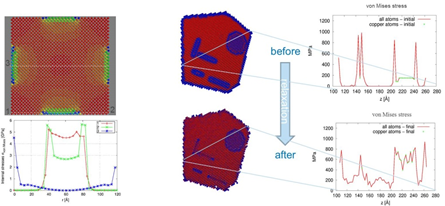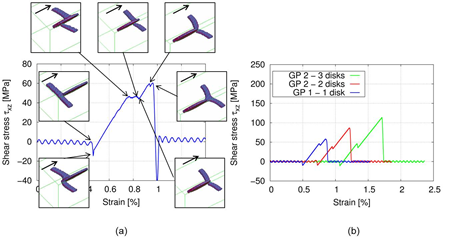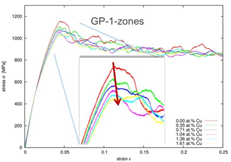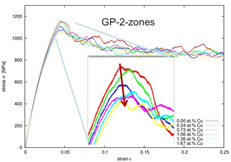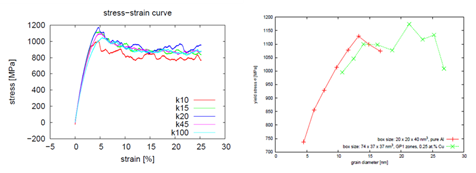Results
Initial structures
In this project here besides the usual atomistic single crystal simulations complex structures should be used. In order to comply with these conditions we combined various software routines, both pre-existent and self-developed. In this way it has been possible to generate poly crystals which have an average diameter in the order of up to 40 nm (see Figure 1). Since the focus of the project lies on the different phases of precipitation formation, those constructed aluminum nano crystals are alloyed with copper. While statistically randomly selected aluminum atoms on the aluminum crystal lattice were replaced by copper atoms for the solid solution crystal. The insertion of the GP-1-zones takes already place during the construction of the nano crystal. The monoatomic copper discs are here with statistically uniformly distributed normal vectors [(100)(010)(001)] on the {100} crystallographic planes, their frequency per grain and their radii can be defined as a parameter. Positioning at the grain boundary or a mutual cutting is excluded from the algorithm. The structure forming of the further aged GP-2-zones are in a corresponding manner. The GP-2-zone is made up of three GP-1-zones, between which there are three layers of aluminum. The configurations hereby created to be used as initial conditions for subsequent molecular dynamics simulations.
|
Coherence and internal stresses
The mutually different bond lengths of aluminum and copper atoms in the sample structure lead to coherent tensions. To quantify these residual stresses, the von Mises equivalent stress was used. It was evaluated for the GP-1-zone in the single crystal as well as in multi-grain system. In the crystal, two GP-1-zones were introduced and considered; the stress profile is shown along the in Figure 2 (a) marked paths. Von Mises equivalent stresses of about 5 GPa are formed at the aluminum-copper interface. The second path provides for the aluminum atoms which are positioned parallel to the copper plate a stress value which is reduced to approximately half of the value of the copper atoms. The range of the stress field along the GP-zone is limited to a few atomic layers. In a direction normal to the disc, however, the tension is noticeable after ten lattice constants. In the grain of the poly crystal in Figure 2 (b) a similar picture emerges at the beginning of simulated relaxation as in the single crystal. The edges of the GP zones cause high tensions in the configuration. In addition to the previously analyzed effects also the grain boundary areas are under tension. After the molecular dynamics relaxation it is shown that the areas of high residual stresses are expanded. Over the entire region of the cross section there is a non-zero stress. It is further noted that the value of the residual stress at the edges of GP-zones is approximately equal to the values takes of the atoms at the grain boundaries.
|
Dislocation motion through obstacle fields
For the isolated analysis of the interaction of dislocations with the obstacle fields represented by the copper atoms, a mono crystalline system is used. In this single crystal, first, an edge dislocation is inserted by removal of two half- layers of aluminum atoms, afterwards aluminum atoms are substituted by copper atoms according to the desired precipitation. On the aluminum copper system produced in this way shear simulations were performed. In Figure 3 (a) different stages of the cutting process of a dislocation through a GP-1-zone are exemplarily depicted. Shown are atoms which have a different number of nearest neighbors compared to a perfect fcc-lattice, stacking fault between the partial dislocations and copper atoms, for distinctive marks in the course of the shear stress over the shear. After the impact of the dislocation on the GP-1-zone one half of the dislocation moves leading along the copper disk. With continued shearing, the second half of the displacement is following up and it involves a further increase of the shear force necessary to establish the depinning. The depinning stresses (CRSS) for the different copper concentrations have been identified. For the GP zones, the value of the CRSS at the same copper concentration increases significantly compared to the value of dissolved copper. The increase of the CRSS in the transition from GP-1- to GP-2-zone is not of that extend. For the (100)- and the (010)-orientation of the GP zone an additional second copper disk increases the CRSS by about 20 percent from 165 to 200 GPa, more discs have no additional effect. In the (001)-oriented GP-zone, the CRSS increases linearly with the number of disks, but the increase per slice is less than the CRSS of a GP-1-zone (see Figure 3 ( b)).
|
Influence of copper on the tensile strength
Molecular Dynamics Simulations have shown that the substitution of aluminum with copper atoms leads to a change in the maximum stress in tensile tests. However, contrary to the experimental experience the maximum voltage of the system is reduced by the impurity atoms, as shown in Figure 4. No dislocations are initially present in the simulations. Therefore the maximum value of the stress is the one which is necessary to generate a dislocation. Here, the inserted copper atoms act as lattice defects, which facilitate the formation of dislocations, so a network of dislocations is build up in the course of the simulation. Comparing the different precipitations according to their aging stages, it is observed that the same number of copper atoms lead to a larger reduction when they are constituted in the discs of GP-zones compared to solid solution crystal.
|
|
Inverse Hall -Petch effect
Inverse Hall -Petch effect For examining the transition of the inverse to the normal Hall-Petch effect, poly crystals are produced in the computer having the same volume of the simulation cell but differ in the number of grains. It results in a variation of the average grain diameter of 5 nm to 27 nm as exemplarily illustrated in Figure 1. In Figure 5, five stress-strain curves are shown. They consist of an elastic part, followed by a peak of the stress. Afterwards the stress decreases to a plateau, at which the values fluctuate slightly. As the relevant variable for the strength the maximum stress of the stress-strain curve was used. The influence of the average grain diameter on the strength was evaluated. In the simulations presented here, a change of the Hall-Petch to the inverse Hall-Petch effect was observed with an average particle diameter of 13.5 nm for pure aluminum. The addition of copper in the appearance of GP-1-zones is resulting in a displacement of the particle diameter - dependent maximum stress to a larger average diameter of 21.25 nm.
|



